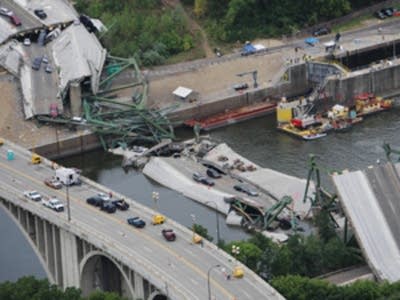Court rulings on I-35W bridge rattle builders

Five years ago tomorrow, the Interstate 35W bridge spanning the Mississippi River in Minneapolis collapsed. The steel and concrete structure fell into the river, killing 13 people and injuring 145 others.
After the collapse, Minnesota lawmakers had no doubt that, as the owner of the bridge, the state would be at the center of a legal dispute.
"We knew that the state was going to get sued," said state Sen. Ron Latz, DFL-St. Louis Park.
Latz led the Senate's effort to provide compensation for victims of the disaster. The year after the collapse lawmakers set up a fund that distributed a total of $37 million to nearly 180 victims. It was modeled after the fund for victims of the Sept. 11, 2001 terrorist attacks.
Create a More Connected Minnesota
MPR News is your trusted resource for the news you need. With your support, MPR News brings accessible, courageous journalism and authentic conversation to everyone - free of paywalls and barriers. Your gift makes a difference.
But unlike Congress, Latz said, Minnesota expected to recover some of the payments through the courts.
"I think there was a certain degree of confidence that the state would recoup at least a substantial portion of that money from third-party sources such as the company that had designed and originally constructed the bridge."
But construction industry officials warn that the state law paving the way for those lawsuits, and the court rulings that followed, have set a dangerous precedent.
Because the bridge was more than 40 years old, under Minnesota law companies that built the structure were no longer liable for mishaps.
So the legislature included in the compensation fund law a provision to nullify the statute of limitations in the case of the I-35W bridge collapse. That allowed lawyers for Minnesota to seek money from Jacobs Engineering Group, the successor to the now-defunct company that designed the bridge in the 1960s.
Jacobs Engineering fought the provision in the courts but ultimately lost. The U.S. Supreme Court refused to take up the case in May, so, the law stands.
That alarms a lot of people, including Minneapolis construction attorney Bob Huber. He isn't involved in any I-35W litigation, but wrote a paper on the compensation law for the American Bar Association earlier this year.
"The Minnesota Supreme court said 'we acknowledge that it may be economically unfair... but we find nothing in the due process clause to preclude this result,' " Huber wrote. "Under this ruling now, let's say the Stone Arch Bridge collapsed. The state could pass a statute if it chose to pursue the entity that built or designed the bridge. A hundred-and-some years ago."
Huber said the Minnesota precedent is making the construction industry nervous as bridges and other structures throughout the country age and deteriorate.
"Other states could follow suit and if there's a mass disaster, the legislature could come in and sweep away the protection that they had relied on," he said.
None of the parties involved in the case responded to repeated requests for comment. In court documents, the Minnesota Attorney General's office argued the I-35W collapse was a "discreet and unprecedented event" and the ruling will not incite other states to change their statutes of limitations.
Either way, the Minnesota Supreme Court decision could further hurt the construction industry, which has yet to recover from the Great Recession, said Tom Smith deputy executive director of the American Society of Civil Engineers. Most immediately, he said the ruling could raise insurance rates for contractors.
"The cost of doing business in design and construction are now going to go up," said Smith, also the engineering group's general counsel. "And this is happening as you know when the economy hasn't fully recovered and we're woefully under spending on infrastructure. So you really need to be encouraging design and construction and this is just going to make risk higher."
In the case of the I-35W bridge, Latz said it was worth asking a key question: Does it matter if the bridge collapsed within 10 years of construction or 40 years, if the structure was flawed from the start, as investigators later diagnosed?
"There were fundamental errors in design and construction for that bridge," he said. "And the question is at some point, who's responsible for it? How long should a party be responsible for their fundamental errors?"
Latz said he doesn't think it was unfair for those questions to be answered by the courts.
